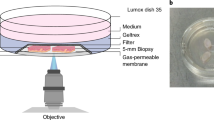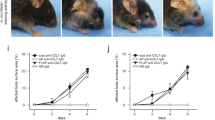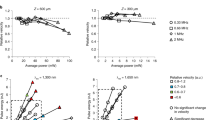Abstract
Transplant rejection involves a coordinated attack of the innate and the adaptive immune systems of the host. To investigate this dynamic process and the contributions of both donor and host cells, we developed an ear skin graft model suitable for intravital imaging. We found that donor dermal dendritic cells (DCs) migrated rapidly from the graft and were replaced by host CD11b+ mononuclear cells. The infiltrating host cells captured donor antigen, reached the draining lymph node and cross-primed graft-reactive CD8+ T cells. Furthermore, we defined the mechanisms by which host T cells target graft cells. We found that primed T cells entered the graft from the surrounding tissue and localized selectively at the dermis-epidermis junction. Later, CD8+ T cells disseminated throughout the graft and many became arrested. These results provide insights into the antigen presentation pathway and the stepwise progression of CD8+ T cell activity, thereby offering a framework for evaluating how immunotherapy might abrogate the key steps in allograft rejection.
This is a preview of subscription content, access via your institution
Access options
Subscribe to this journal
Receive 12 print issues and online access
$209.00 per year
only $17.42 per issue
Buy this article
- Purchase on Springer Link
- Instant access to full article PDF
Prices may be subject to local taxes which are calculated during checkout





Similar content being viewed by others
References
Auchincloss, H. Jr. & Sultan, H. Antigen processing and presentation in transplantation. Curr. Opin. Immunol. 8, 681–687 (1996).
Rosenberg, A.S. & Singer, A. Cellular basis of skin allograft rejection: an in vivo model of immune-mediated tissue destruction. Annu. Rev. Immunol. 10, 333–360 (1992).
Ingulli, E. Mechanism of cellular rejection in transplantation. Pediatr. Nephrol. 25, 61–74 (2010).
Talmage, D.W., Dart, G., Radovich, J. & Lafferty, K.J. Activation of transplant immunity: effect of donor leukocytes on thyroid allograft rejection. Science 191, 385–388 (1976).
Richards, D.M. et al. Indirect minor histocompatibility antigen presentation by allograft recipient cells in the draining lymph node leads to the activation and clonal expansion of CD4+ T cells that cause obliterative airways disease. J. Immunol. 172, 3469–3479 (2004).
Ochando, J.C., Krieger, N.R. & Bromberg, J.S. Direct versus indirect allorecognition: Visualization of dendritic cell distribution and interactions during rejection and tolerization. Am. J. Transplant. 6, 2488–2496 (2006).
Larsen, C.P., Austyn, J.M. & Morris, P.J. The role of graft-derived dendritic leukocytes in the rejection of vascularized organ allograft. Recent findings on the migration and function of dendritic leukocytes after transplantation. Ann. Surg. 212, 308–315 (1990).
Valujskikh, A., Hartig, C. & Heeger, P.S. Indirectly primed CD8+ T cells are a prominent component of the allogeneic T-cell repertoire after skin graft rejection in mice. Transplantation 71, 418–421 (2001).
Garrod, K.R. et al. NK cell patrolling and elimination of donor-derived dendritic cells favor indirect alloreactivity. J. Immunol. 184, 2329–2336 (2010).
Lakkis, F.G., Arakelov, A., Konieczny, B.T. & Inoue, Y. Immunologic 'ignorance' of vascularized organ transplants in the absence of secondary lymphoid tissue. Nat. Med. 6, 686–688 (2000).
Zhou, P. et al. Secondary lymphoid organs are important but not absolutely required for allograft responses. Am. J. Transplant. 3, 259–266 (2003).
Barker, C.F. & Billingham, R.E. The role of afferent lymphatics in the rejection of skin homografts. J. Exp. Med. 128, 197–221 (1968).
Wang, J. et al. Donor lymphoid organs are a major site of alloreactive T-cell priming following intestinal transplantation. Am. J. Transplant. 6, 2563–2571 (2006).
Schenk, A.D., Nozaki, T., Rabant, M., Valujskikh, A. & Fairchild, R.L. Donor-reactive CD8 memory T cells infiltrate cardiac allografts within 24-h post-transplant in naive recipients. Am. J. Transplant. 8, 1652–1661 (2008).
Kreisel, D. et al. Non-hematopoietic allograft cells directly activate CD8+ T cells and trigger acute rejection: an alternative mechanism of allorecognition. Nat. Med. 8, 233–239 (2002).
Gelman, A.E. et al. Cutting edge: Acute lung allograft rejection is independent of secondary lymphoid organs. J. Immunol. 182, 3969–3973 (2009).
Rocha, P.N., Plumb, T.J., Crowley, S.D. & Coffman, T.M. Effector mechanisms in transplant rejection. Immunol. Rev. 196, 51–64 (2003).
Strid, J. et al. Acute upregulation of an NKG2D ligand promotes rapid reorganization of a local immune compartment with pleiotropic effects on carcinogenesis. Nat. Immunol. 9, 146–154 (2008).
Nishibu, A. et al. Behavioral responses of epidermal Langerhans cells in situ to local pathological stimuli. J. Invest. Dermatol. 126, 787–796 (2006).
Peters, N.C. et al. In vivo imaging reveals an essential role for neutrophils in leishmaniasis transmitted by sand flies. Science 321, 970–974 (2008).
Chtanova, T. et al. Dynamics of neutrophil migration in lymph nodes during infection. Immunity 29, 487–496 (2008).
Matsuo, S., Kurisaki, A., Sugino, H., Hashimoto, I. & Nakanishi, H. Analysis of skin graft survival using green fluorescent protein transgenic mice. J. Med. Invest. 54, 267–275 (2007).
Ehst, B.D., Ingulli, E. & Jenkins, M.K. Development of a novel transgenic mouse for the study of interactions between CD4 and CD8 T cells during graft rejection. Am. J. Transplant. 3, 1355–1362 (2003).
Konjufca, V. & Miller, M.J. Two-photon microscopy of host-pathogen interactions: acquiring a dynamic picture of infection in vivo. Cell. Microbiol. 11, 551–559 (2009).
Ng, L.G., Mrass, P., Kinjyo, I., Reiner, S.L. & Weninger, W. Two-photon imaging of effector T-cell behavior: lessons from a tumor model. Immunol. Rev. 221, 147–162 (2008).
Kissenpfennig, A. et al. Dynamics and function of Langerhans cells in vivo: dermal dendritic cells colonize lymph node areas distinct from slower migrating Langerhans cells. Immunity 22, 643–654 (2005).
Sen, D., Forrest, L., Kepler, T.B., Parker, I. & Cahalan, M.D. Selective and site-specific mobilization of dermal dendritic cells and Langerhans cells by TH1- and TH2-polarizing adjuvants. Proc. Natl. Acad. Sci. USA 107, 8334–8339 (2010).
Wang, L. et al. Langerin expressing cells promote skin immune responses under defined conditions. J. Immunol. 180, 4722–4727 (2008).
Obhrai, J.S. et al. Langerhans cells are not required for efficient skin graft rejection. J. Invest. Dermatol. 128, 1950–1955 (2008).
Beil, W.J., Meinardus-Hager, G., Neugebauer, D.C. & Sorg, C. Differences in the onset of the inflammatory response to cutaneous leishmaniasis in resistant and susceptible mice. J. Leukoc. Biol. 52, 135–142 (1992).
Léon, B., Lopez-Bravo, M. & Ardavin, C. Monocyte-derived dendritic cells formed at the infection site control the induction of protective T helper 1 responses against Leishmania. Immunity 26, 519–531 (2007).
Robben, P.M., LaRegina, M., Kuziel, W.A. & Sibley, L.D. Recruitment of Gr-1+ monocytes is essential for control of acute toxoplasmosis. J. Exp. Med. 201, 1761–1769 (2005).
Benichou, G., Valujskikh, A. & Heeger, P.S. Contributions of direct and indirect T cell alloreactivity during allograft rejection in mice. J. Immunol. 162, 352–358 (1999).
Le Borgne, M. et al. Dendritic cells rapidly recruited into epithelial tissues via CCR6/CCL20 are responsible for CD8+ T cell crosspriming in vivo. Immunity 24, 191–201 (2006).
Valujskikh, A., Lantz, O., Celli, S., Matzinger, P. & Heeger, P.S. Cross-primed CD8+ T cells mediate graft rejection via a distinct effector pathway. Nat. Immunol. 3, 844–851 (2002).
Rosenberg, A.S. & Singer, A. Evidence that the effector mechanism of skin allograft rejection is antigen-specific. Proc. Natl. Acad. Sci. USA 85, 7739–7742 (1988).
Breart, B., Lemaitre, F., Celli, S. & Bousso, P. Two-photon imaging of intratumoral CD8+ T cell cytotoxic activity during adoptive T cell therapy in mice. J. Clin. Invest. 118, 1390–1397 (2008).
Boissonnas, A., Fetler, L., Zeelenberg, I.S., Hugues, S. & Amigorena, S. In vivo imaging of cytotoxic T cell infiltration and elimination of a solid tumor. J. Exp. Med. 204, 345–356 (2007).
Van den Broeck, W., Derore, A. & Simoens, P. Anatomy and nomenclature of murine lymph nodes: Descriptive study and nomenclatory standardization in BALB/cAnNCrl mice. J. Immunol. Methods 312, 12–19 (2006).
Celli, S., Garcia, Z. & Bousso, P. CD4 T cells integrate signals delivered during successive DC encounters in vivo. J. Exp. Med. 202, 1271–1278 (2005).
Acknowledgements
We wish to thank H. Saklani and C. Auriau (Institut Pasteur) for providing B2m−/− mOVA mice and E. Robey and the members of the Bousso laboratory for comments on the manuscript. This work was supported by INSERM, Institut Pasteur and a Marie Curie Excellence grant.
Author information
Authors and Affiliations
Contributions
S.C. designed and carried out the experiments, analyzed the data and wrote the manuscript; M.L.A. developed crucial reagents and participated in experimental design; and P.B. designed the experiments, analyzed the data and wrote the manuscript.
Corresponding author
Ethics declarations
Competing interests
The authors declare no competing financial interests.
Supplementary information
Supplementary Text and Figures
Supplementary Figures 1–8 (PDF 1093 kb)
Supplementary Video 1
Mobility of donor dendritic cells in the graft (MOV 2340 kb)
Supplementary Video 2
Donor DCs rapidly die in the draining lymph node (MOV 2012 kb)
Supplementary Video 3
The motility of graft-infiltrating host cells changes over time (MOV 1147 kb)
Supplementary Video 4
Infiltration of the epidermis in the presence of antigenic mismatch (MOV 2506 kb)
Supplementary Video 5
Recipient graft-infiltrating cells are visualized following retransplant (MOV 1091 kb)
Supplementary Video 6
Recipient graft-infiltrating cells can reach the draining lymph node (MOV 2089 kb)
Supplementary Video 7
Skin allografts are efficiently revascularized on day 5 (MOV 3659 kb)
Supplementary Video 8
CD8+ T cells accumulate in the recipient tissue around the graft (MOV 3789 kb)
Supplementary Video 9
CD4+ T cells accumulate in the recipient tissue around the graft (MOV 660 kb)
Supplementary Video 10
CD4+ T cells localize at the dermis/epidermis junction as they enter the graft (MOV 931 kb)
Supplementary Video 11
CD8+ T cells colocalize with propidium iodide positive cells in the allograft (MOV 3328 kb)
Supplementary Video 12
CD8+ T cells colocalize with propidium iodide positive cells in the allograft (MOV 4226 kb)
Supplementary Video 13
CD8+ T cells colocalize with propidium iodide positive cells in the allograft (MOV 686 kb)
Supplementary Video 14
CD8+ T cells colocalize with propidium iodide positive cells in the allograft (MOV 1068 kb)
Supplementary Video 15
CD8+ T cells displayed reduced motility and increased confinement in the allograft (MOV 3723 kb)
Rights and permissions
About this article
Cite this article
Celli, S., Albert, M. & Bousso, P. Visualizing the innate and adaptive immune responses underlying allograft rejection by two-photon microscopy. Nat Med 17, 744–749 (2011). https://doi.org/10.1038/nm.2376
Received:
Accepted:
Published:
Issue Date:
DOI: https://doi.org/10.1038/nm.2376
This article is cited by
-
Activation and regulation of alloreactive T cell immunity in solid organ transplantation
Nature Reviews Nephrology (2022)
-
Multiphoton intravital microscopy of rodents
Nature Reviews Methods Primers (2022)
-
Host responses to implants revealed by intravital microscopy
Nature Reviews Materials (2021)
-
A late B lymphocyte action in dysfunctional tissue repair following kidney injury and transplantation
Nature Communications (2019)
-
Role of myeloid regulatory cells (MRCs) in maintaining tissue homeostasis and promoting tolerance in autoimmunity, inflammatory disease and transplantation
Cancer Immunology, Immunotherapy (2019)



